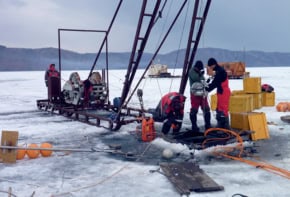In November a group of scientists will scour a small patch of the Middle East for signs that a nuclear explosion has taken place. Edwin Cartlidge describes their delicate mission and the sophisticated gadgetry they will rely on

At 2.57 a.m. GMT on 12 February 2013, seismometers around the world detected an earthquake of magnitude 4.9. Globally, a quake of that size is an unremarkable event – more than 1000 take place every year. But the seismic waves generated by the tremor showed something unusual. The quake had taken place in a corner of east Asia relatively unaffected by seismic activity and it appeared not to be caused by the tectonic processes that trigger most earthquakes. Rather, it looked to be man-made. In fact, as confirmed shortly afterwards by the country’s official news agency, the event had been generated by a nuclear test in North Korea.
The third and most powerful test that North Korea has carried out to date, the explosion was condemned by leaders around the world as a threat to regional and international security. More specifically, the event was a blow to the Comprehensive Nuclear-Test-Ban Treaty (CTBT), which bans all signatory nations from carrying out nuclear tests anywhere – on the Earth’s surface, underground, underwater, in the atmosphere or in outer space. Since it came into being in 1996, more than 180 nations have signed the CTBT, but a handful, including North Korea, have not, while others – notably the US – have still to ratify it, which means it is not yet in force (see “Testing times” below).
The fact that the North Korean test was detected and then quickly identified as a suspicious event shows that a global network of listening devices known as the International Monitoring System (IMS) was working as planned. Consisting of hundreds of seismic, acoustic and radioactive sensors dotted around the planet (see “Listening out for treaty violators” below), the IMS provides the first evidence that a country has violated the CTBT. However, until the treaty comes into force, the organization responsible for carrying out the monitoring – the Comprehensive Nuclear-Test-Ban Treaty Organization (CTBTO) – cannot carry out the final and crucial part of its verification regime: on-site inspection.
Such an inspection would involve experts entering a country suspected of having carried out a nuclear test, and deploying advanced instruments close to the presumed “ground zero” to prove whether or not a test has taken place. Such an operation would be politically delicate as inspectors would be granted wide-ranging powers to search a large area of a country, which may then face severe sanctions. The inspection would also be highly complex, involving dozens of people from different countries and with different backgrounds transporting themselves and more than 150 tonnes of equipment to a probably remote spot where they would live and work for several months. Meanwhile, the clock would be ticking, since much of the evidence – such as seismic aftershocks and radioactive emissions – diminishes rapidly in the wake of an explosion.
In an attempt to put such an operation to the test, a group of roughly 40 scientists and technicians will arrive in Jordan this November. Experts in seismology, geophysics, nuclear physics and other disciplines, the team will head to a site on the banks of the Dead Sea, where they will spend three or four weeks combing roughly 1000 km2 of mountainous desert and scrubland for signs that a fictitious nuclear device was detonated underground in the days or weeks before they arrived.
The aim of this elaborate role-playing game – known as the Integrated Field Exercise 2014 – is to recreate as closely as possible almost all of the elements of a real on-site inspection. It will therefore include evidence suggestive of a recent nuclear test as well as people who will be the inspectors’ adversaries, namely representatives of the state under inspection. The CTBTO’s Gordon Macleod, who leads the team that devised the fictional scenario to be played out in Jordan, says that the role-playing inspectors – like their real counterparts – will have their work cut out trying to be as exhaustive and as fair as possible, while dealing with the inspected state trying to throw them off the scent.
“The really hard part would be proving no test had taken place,” says Macleod. “As an inspector you would say that you do not have the evidence that could prove a nuclear explosion occurred. But the people who made the request can always say that you didn’t look in the right place.”
Locating ground zero
Underground explosions have been the most common kind of nuclear test, accounting for around three-quarters of those carried out during the Cold War. In general they are not as spectacular as atmospheric, above-ground or underwater blasts and do not release as much radioactive fallout, but they do have their own tell-tale signs. In particular, an underground explosion generates temperatures and pressures high enough to vaporize rock and create an underground cavity measuring up to several tens or hundreds of metres across. Around this cavity, rock is crushed, cracked, inelastically deformed and then elastically deformed in successive layers. It is in this last, outermost, layer that seismic waves are created – the rock within it relaxing back to its former state and releasing the strain that had temporarily built up.
These waves, which can be detected in minutes by seismometers up to thousands of kilometres from the test site, provide information on the strength, location and nature of an event. But the waves cannot reveal for sure if an event is due to a nuclear test or to something more conventional, such as a chemical blast in a mine or an earthquake (see figure below). Acoustic data collected by underwater microphones and by “infrasound” stations are also important, but the “smoking gun” of a nuclear test is radioactive emissions, such as from xenon, which differ substantially from those of a nuclear power plant.

Together, these four data streams make up the outputs of the IMS and are sent from their respective monitoring stations in near real-time via satellite and ground links to the CTBTO in Vienna, Austria. There the data are first processed automatically by computers, which identify specific events and calculate their distances, and then by human analysts, who add missed events and correct wrongly attributed ones. After the numerous natural events have been filtered out, analysts send preliminary lists of suspicious events to the signatory states of the CTBT.
Anders Ringbom, a noble-gas expert at the Swedish Defence Research Agency, likens the multi-pronged monitoring effort to a legal investigation. “It is like a court case where you are looking for pieces of evidence and trying to put them together,” he says. “The more evidence you have the stronger your case is.” Unfortunately, the evidence from the IMS is not always enough to convince signatories of the CTBT that a nuclear test has taken place. The network did not, for example, detect any radionuclides following a test North Korea carried out in 2009, and it was nearly two months before stations in Japan and Russia picked up radioactive noble gases after the 2013 test.
This is where the on-site inspection would come in. With the CTBT yet to enter into force, no such inspection has ever taken place for real. But if the treaty does eventually become legally binding, then such investigations would play a central role. The mere fact that an on-site inspection could take place, reasoned the negotiators who drew up the CTBT, ought to deter any state from carrying out a nuclear test in the first place. But if a test is believed to have been carried out, then measurements at the site of the presumed explosion would provide far more sensitive measurements than is possible remotely, and would therefore give treaty parties more confidence in pressing for any sanctions.
Once an inspection request from one or more states has been approved by the CTBTO’s executive council, inspectors would travel to the site of the alleged test and set up camp. Top of their to-do list would be to survey the surrounding terrain from a helicopter to look for any suspicious geological features, such as rock falls, sinkholes or other depressions. Of particular interest would be large craters, up to several hundred metres across, that could have been caused by rock above the blast cavity collapsing. Initially, that rock is supported by high-pressure steam formed by the explosion, but once temperatures drop and the steam condenses, the rock can give way to produce a “rubble chimney” that can extend to the surface.
Inspectors can also make more careful measurements of the phenomena observed by the IMS. In particular, they can set up a network of extremely sensitive seismometers in the inspection area to record the weakening aftershocks created by a nuclear explosion. Another crucial activity is testing samples of air, soil, vegetation and water for the presence of radioactive particles, and gases such as argon, which is produced when neutrons from a nuclear explosion slam into rocks.
If evidence of the cavity is not visible at ground level, inspectors have other tools up their sleeve, including “gravitational field mapping”, which is sensitive to variations in the density of rock underground, as well as instruments that measure changes in subterranean electrical conductivity. They can also use ground-penetrating radar or sensitive magnetic-field detectors to search for suggestive objects, such as pipes or cables that might have formed part of the test infrastructure.
If inspectors are confident of having precisely located the test site, they have one final technique they can call upon. Assuming they can get permission from the CTBTO’s executive council, they can drill a hole down to the explosion cavity and extract samples of solid or molten rock containing radioactive material. According to Matjaz Prah, the CTBTO’s on-site inspection co-ordinator, any relevant fission products in the rock would be “undeniable evidence” of a nuclear test, pointing out that if the explosion had been very deep – it could be up to several kilometres below the Earth’s surface – radioactive xenon and argon might not emerge at all.
The appliance of science
The IMS has developed a lot over the last decade, with the number of facilities rising from three at the end of 2000 to 278 now. With another 59 needed to complete the network, gaps remain, however – there are no monitoring stations, for example, in India or Pakistan. Still, according to a 2012 report from the US National Academy of Sciences, the IMS in its current form will already make life tough for any potential test-ban violator. The report estimated that only explosions with yields below about 1 kilotonne could be confidently hidden from the network’s 38 primary seismic stations (now 42), which is too feeble to allow the test nation to develop powerful or novel nuclear weapons.
Our ability to detect down to such levels is partly due to there being more monitoring stations than in the past. But it is also due to a greater use of “regional” seismic waves – defined as those detected within about 1500 km of their source – which provide valuable information about low-yield events. These waves travel through the crust and upper mantle – which are far more complex than the more homogenous material deeper down – and so are generally harder to interpret than long-range “teleseismic” waves. Fortunately, improved models of the Earth’s structure developed over the last decade mean that regional seismic data can now yield monitoring sensitivities for many continental areas 10 times greater than is possible with teleseismic waves.
However, while the CTBTO’s global monitoring is close to completion, its on-site inspection capabilities have lagged behind. The organization (technically called the CTBTO Preparatory Commission as the treaty is not yet in force) has previously carried out simulated inspections, including one in 2008 in Kazakhstan at the Semipalatinsk nuclear test site used by the Soviet Union in the Cold War. Inspectors, however, had access to only basic detector technology, which limited them largely to visual inspection and measuring seismic aftershocks.
The Jordan exercise should give participants a much better feel for what can be achieved on the ground. To investigate the scenario laid out for them by Macleod’s team, which is itself a major technical challenge (see “Planting a fake bomb (or not)” below), the role-playing experts will have access to almost all sensor technologies available to them under the terms of the CTBT. These include using ultraviolet light, which can penetrate dirt on the ground and so perhaps reveal the tracks of vehicles used to set up the test site, as well as infrared radiation, which could point to the location of the explosion by measuring heat escaping through cracks in the Earth’s surface. Inspectors will also use portable equipment, such as noble-gas detection systems, to measure the tell-tale gases xenon and argon.
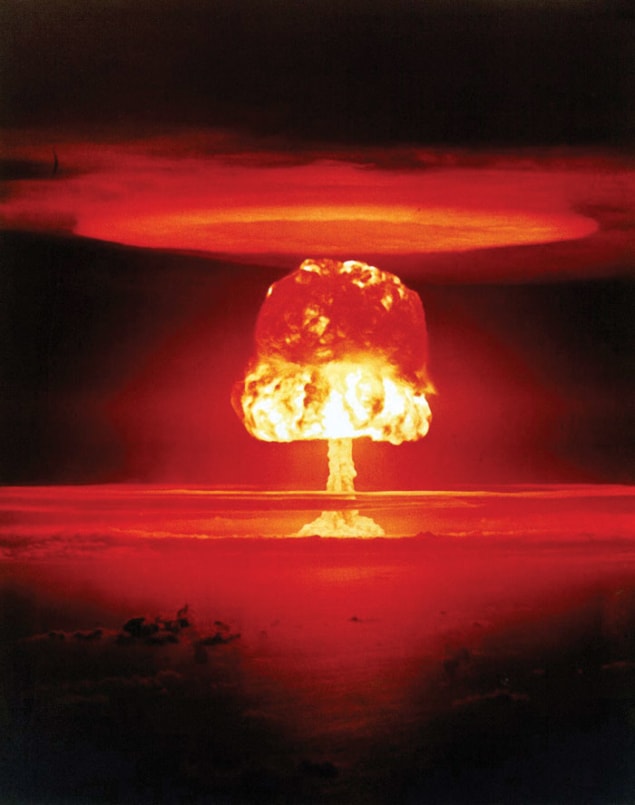
Assessing whether or not a virtual nuclear device has been detonated will be more than a technical challenge, however. In particular, role-playing representatives of the inspected state might invoke a treaty clause to let them seal off certain areas for reasons of “national security”. The inspectors, says Prah, will “have to use all the means foreseen by the treaty to get hold of the data they need”, which could involve them carrying out lengthy negotiations with their hosts.
But Prah adds that inspectors will have to stick to what is relevant – even uranium enrichment cannot be reported because it is, strictly speaking, unrelated, while ballistic-missile development would not be a violation of the CTBT. “As an inspector you come open-minded and simply try and understand what is going on, without any prejudices,” he says. “Your job is to collect data. Whether or not there has been a violation is a political decision.” Prah nevertheless believes that the wide range of evidence available to inspectors in Jordan should leave no doubt as to what has gone on. “I think that our on-site inspection capabilities have improved hugely over the last four or five years,” he says. “With these developments, those who violate the treaty will have nowhere to hide.”
Some gaps will remain. Participants in the Integrated Field Exercise 2014 will not do any drilling, which would require a massive oil-field-sized rig that is beyond the $10m budget of the exercise. Also absent in Jordan will be “resonance seismometry”, which could help inspectors to find an explosion cavity by measuring variations in tiny background tremors that pass through different rock layers. “We haven’t fully got to grips with how this technique would work in an on-site inspection regime,” says Macleod. “It is still in an R&D stage.”
Other research to improve the IMS, meanwhile, includes “cross-correlating” the seismic waveforms of new events with those of historical tremors to help to identify new blasts. The CTBTO is also working with the World Meteorological Organization to improve atmospheric transport models, which are used to calculate where and when radioactive particles come from. In addition, the CTBTO’s huge data bank of noble-gas measurements could, says Ringbom, be scrutinized for patterns to improve our understanding of the radionuclide background.
But as Jerry Carter – a chief CTBTO data analyst – points out, the organization does not develop any of these techniques itself, relying instead on academics communicating their work or carrying out dedicated research on the CTBTO’s behalf. Recent relevant advances, says Carter, include research on whale noise, which has helped the understanding of the background registered by hydrophones, and the development of a self-calibrating infrasound sensor. “New technologies and scientific developments are really important to us,” he says, “so we look to see what is out there and try to incorporate whatever is most relevant.”
However, such research will remain under-used until the treaty is brought into force. David Hafemeister, a physicist and arms-control expert at the California Polytechnic State University, thinks that US president Barack Obama “won’t push hard” for American ratification of the CTBT despite saying he strongly supports it. In 1999 almost all Republican senators voted against ratification and Hafemeister thinks it might take a Republican president “to bring along his or her colleagues”. At that point, he speculates, were China to lean on North Korea, all eight of the states needed for the treaty to enter into force might ratify it. “The stakes are really high because countries such as China, which has only tested about 50 times, have much more to learn from future tests,” he says. “If we don’t have the test ban, one could imagine unleashing an old-fashioned arms race.”
While the treaty remains on hold, CTBTO scientists will continue to refine and test their monitoring techniques, ensuring that they are as ready as possible if finally called on to investigate what could be the explosion of a real nuclear weapon. The exercise in Jordan should provide a stern test of that preparedness.
Testing times
Efforts to ban nuclear testing have been ongoing since the 1950s when thermonuclear explosions carried out in the atmosphere by the US and the Soviet Union created lots of radioactive fallout. The Partial Nuclear Test-Ban Treaty, signed in 1963, outlawed testing in outer space, in the atmosphere and in the oceans, but it was not until 24 September 1996, once the Cold War had ended, that the Comprehensive Nuclear-Test-Ban Treaty (CTBT) was opened for signature at the United Nations in New York.

Paul Richards, a seismologist at Columbia University in the US, contrasts the CTBT with the Non-Proliferation Treaty. The latter, which came into force in 1970, inhibits what he calls “horizontal proliferation”: it prevents non-nuclear-weapon states from obtaining weapons (in exchange for a commitment from the weaponized states to gradually disarm). The underlying goal of the former, he says, is instead to limit “vertical proliferation” – to restrict the development of more sophisticated nuclear weapons.
Indeed, since the CTBT was opened for signature, none of the five established nuclear powers – the US, Russia, the UK, France and China – has exploded a nuclear weapon, bringing an end to five decades of explosions that saw more than 2000 separate tests of ever more advanced weapons. Other countries, however, have not followed suit. In 1998 two non-signatories, India and Pakistan, carried out nuclear tests within two weeks of one another. Another non-signatory – North Korea – has carried out tests in 2006, 2009 and 2013.
To become legally binding, the CTBT requires that all 44 countries that possessed nuclear technology in 1996 (“Annex 2” states) sign it and then ratify it, which typically means that their parliaments must approve it in a vote. However, eight of those countries have still to do so, including the US. Doubts about the ability of the US and its allies to monitor potential cheating, along with question marks about America’s capacity to maintain a nuclear arsenal without testing, were among the reasons for which the Senate voted against ratification in 1999.
Listening out for treaty violators
The International Monitoring System looks at four types of physical phenomena. The numbers of stations listed for each type are those of the final network, which is currently 83% complete.
1. Seismic waves
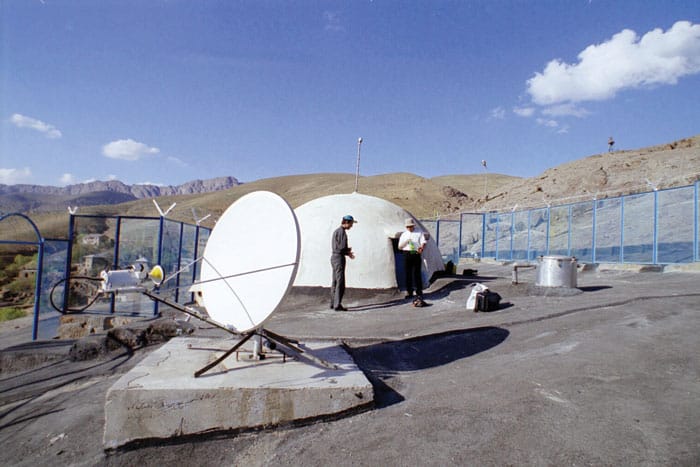
How many? 50 primary and 120 secondary stations What do they do? Each station has either an individual seismometer or an array of up to 25 arranged geometrically over a wide area. Both primary and secondary stations send their data continuously to the Comprehensive Nuclear-Test-Ban Treaty Organization (CTBTO) in Vienna, but only data from the former are used routinely (the latter being called upon when needed). The time lag between fast-moving, longitudinal “primary” seismic waves and slower, transverse “secondary” waves can give the distance to an event, while data from several stations can be combined to yield rough values for the location and depth of an explosion. Nuclear blasts can be distinguished from earthquakes by comparing the two types of wave.
2. Radioactive nuclei

How many? 80 stations and 16 laboratories What do they do? Using filters, the stations extract from the passing air solid particles with distinct radioactive signatures produced by atmospheric, underwater and some shallow underground fission explosions. To detect deep-buried explosions, which do not release such particles to the air, half of the stations also use a charcoal-based device to extract radioactive xenon isotopes. Gaseous xenon is inert and so does not combine with debris or dust to form larger solid particles, but can seep through rock to the surface. As for the labs, which are spread across the world, they check the output of the radionuclide stations, providing independent analysis of suspicious-looking samples.
3. Underwater sound waves

How many? 11 stations What do they do? To monitor for underwater nuclear explosions, the CTBTO uses specially adapted microphones suspended 600–1200 m below the sea surface and seismometers on land at 11 islands in the Atlantic, Pacific and Indian oceans. The “hydrophones” detect sound waves given off by a nuclear test, exploiting the fact that such waves can travel very long distances through water, particularly at depths of about 1 km.
4. Infrasonic waves
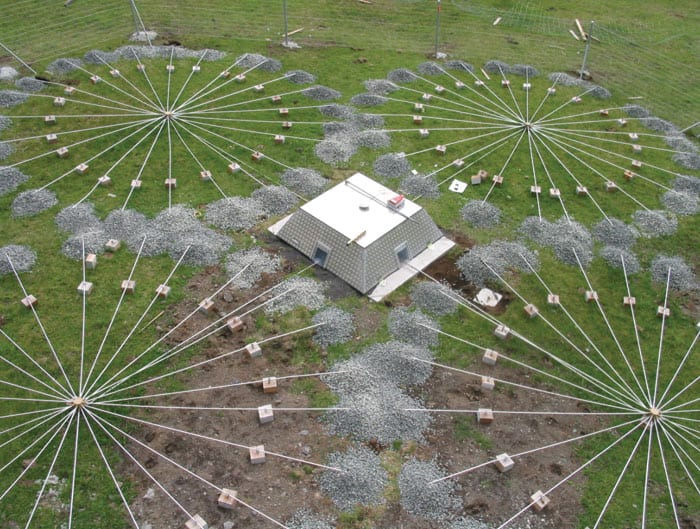
How many? 60 stations What do they do? They pick up very low-frequency sound waves given off by nuclear tests in the atmosphere and at shallow depths underground. The stations, built in 35 different countries, use arrays of microbarometers to measure minute changes in atmospheric pressure, with each barometer sitting at the centre of a set of spoke-like pipes designed to reduce noise generated by the wind.
Planting a fake bomb (or not)
Setting up the inspection area for the Integrated Field Exercise 2014 in Jordan to make it look as if a nuclear test might have taken place (without actually detonating a nuclear bomb) will be a challenge for staff from the Comprehensive Test Ban Treaty Organization. One of the hardest things to recreate will be the correct levels of radionuclides in the air. Rather than actually dispersing radioactive material in the environment, which has health risks, one option is to use a computer simulation to model the spatial variation of the different substances in question and then use this information to automatically and continuously update the readout on the inspectors’ measuring equipment, based on their geographical position as revealed via GPS.
“We had to make sure that the test scenario is scientifically credible and self-consistent, but also difficult,” says Gordon Macleod, who leads the team of scientists and technicians developing the scenario. “The people who are going out there really don’t know whether a virtual bomb has been exploded or not.”
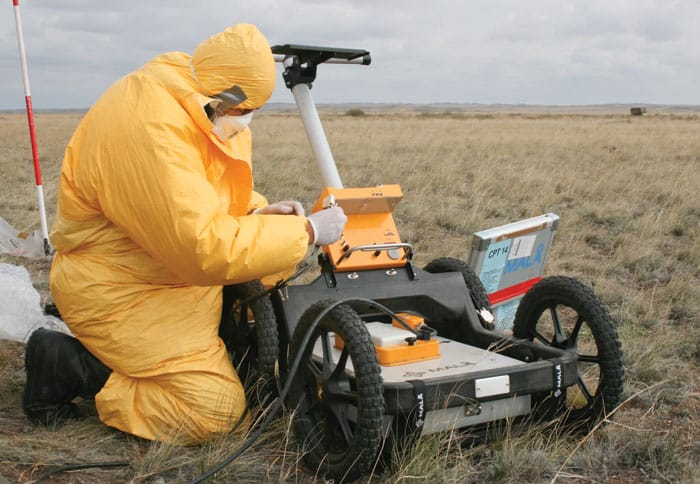
Another headache for those recreating the correct conditions close to ground zero is the set of aftershocks that would accompany a test. Computer simulation is also an option here – the idea being to hijack the seismic data recorded by inspectors in the field and swapping them with “artificial” data before they are analysed. However, says Macleod, experience shows that “this is difficult to do without making it obvious that something has gone on”.
The alternative is to make real (non-tectonic) earthquakes, which can be done using chemical explosions, as was the case in Kazakhstan, or by crashing a huge weight into the ground. Time is on the side of Macleod and his colleagues as at least 10 days will have elapsed before the would-be inspectors can start carrying out their measurements, at which point any aftershocks would be less intense and less frequent, making them easier to imitate.
Unfortunately, however, the shape of the seismic waves differs to some extent between those from nuclear blasts and other man-made events. “There is a risk that people will think the aftershocks look industrial,” says Macleod, who points out that an additional challenge will be making these tremors detectable above the considerable natural seismicity in Jordan.


